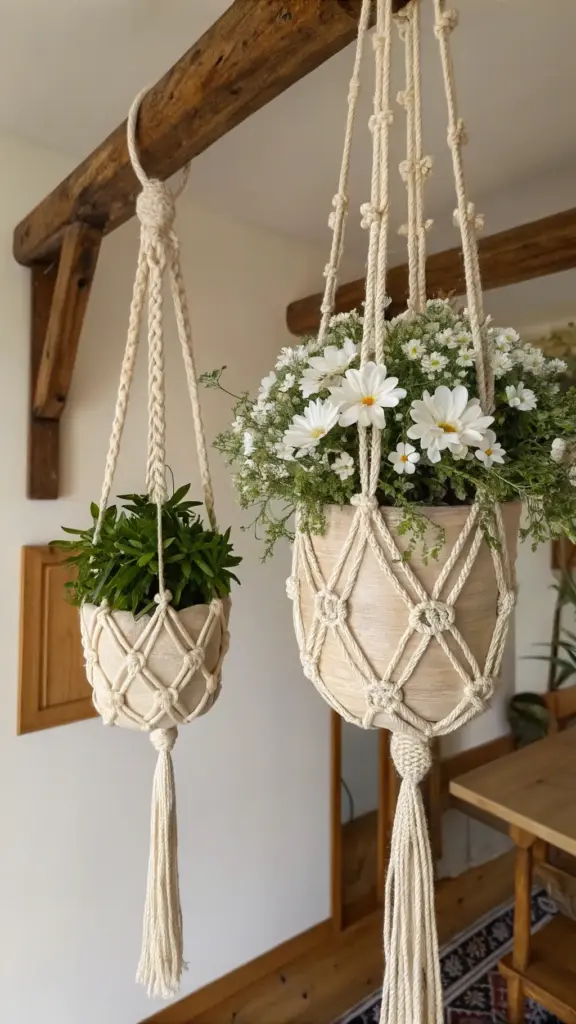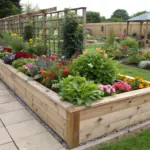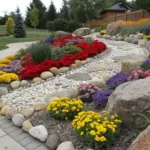2. Hanging Macramé Planters

Let me tell you a story about the time I decided to try my hand at making hanging macramé planters. Spoiler: it didn’t start well. My first attempt looked more like a tangled mess of yarn than anything remotely boho-chic. But here’s the thing—once I got the hang of it (pun totally intended), I realized how addictive this craft can be. Plus, there’s something incredibly satisfying about creating your own decor piece that doubles as a home for your favorite plants. If you’re ready to add some boho flair to your space, let’s dive in!
Why Macramé Planters Are a Must-Have
If you’re into home decor trends, you’ve probably noticed macramé is having a major moment right now. And honestly, it’s not hard to see why. These handmade macramé hangers bring texture, warmth, and personality to any room. They’re also perfectly suited for small spaces because they take up zero floor real estate. Whether you’re hanging them in a sunny corner or by a window, they instantly elevate the vibe.
I’ll never forget the first time I hung one of my finished planters—it was like giving my living room a hug. The soft, natural fibers paired with the greenery of a succulent just made everything feel cozier. Plus, it was a great conversation starter when friends came over. “You made that?!” they’d say. Yup, I sure did.
Step-by-Step Guide to Crafting Your Own Macramé Design
Now, before you panic and think this is too complicated, let me assure you—it’s easier than you think. Here’s a quick rundown to get you started:
- Gather your materials: You’ll need cotton rope (it’s sturdy and looks great), scissors, and a wooden ring or dowel to anchor the design.
- Cut four strands of rope, each about 10 feet long. Fold them in half and attach them to the ring using a lark’s head knot. Don’t worry if it sounds confusing—there are tons of tutorials online!
- Start knotting! Use square knots or spiral knots to create patterns. Keep it simple at first; you can always experiment later.
- Finish by tying all the strands together at the bottom to form a basket-like structure. Trim any excess rope for a clean look.
Pro tip: If you’re new to macramé, practice with scrap fabric first. Trust me, it saves a lot of frustration—and wasted rope.
Pairing Plants with Complementary Textures
One of the coolest things about macramé planters is how versatile they are when it comes to plant pairings. For a minimalist look, go for succulents or air plants—their smooth, sculptural shapes contrast beautifully with the knotted texture of the macramé. On the other hand, trailing plants like string of pearls or spider plants add movement and softness, which complements the structured knots.
Here’s a little secret: pay attention to color coordination. A neutral-toned macramé piece pairs wonderfully with vibrant green foliage, while dyed ropes in earthy tones work great with muted plant colors. It’s all about balance, baby.
Tips for Success
- Lighting matters: Make sure your chosen spot gets enough light for the type of plant you’re using. Succulents love bright, indirect sunlight, while air plants prefer good airflow.
- Choose the right pot size: Small pots work best for macramé hangers since they’re lightweight and easy to manage.
- Experiment with heights: Hang multiple planters at different levels to create visual interest. It’s like building a mini jungle in your home!
And there you have it—a crash course in creating your very own hanging macramé planters. Ready to explore another creative idea? Click the “next” button below to discover how windowsill herb and flower combos can transform your kitchen into a fragrant oasis. Hint: it involves fresh basil and some seriously cute pots. 🌿









GIPHY App Key not set. Please check settings